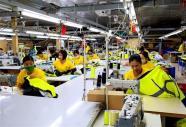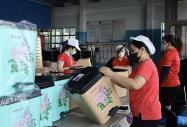Many industry experts view this challenge as a chance to restructure production process and enhance competitiveness.

HÀ NỘI — Amidst the US’s decision to delay new import tariffs for 90 days, Vietnamese businesses are taking advantage of this opportunity to implement both short-term and long-term solutions to minimise potential negative impacts.
Many industry experts view this challenge as a chance to restructure production process and enhance competitiveness.
Maintaining market position amidst tariff threats
According to the Việt Nam Timber and Forest Product Association (Vietforest), wood exports to the US reached US$8.8 billion last year, accounting for over 50 per cent of the industry's total export turnover. Despite the temporary tariff delay, many businesses remain cautious about the future.
Solutions should be outlined to maintain foothold in the US market, it said, elaborating if foreign-invested enterprises, who account for nearly 70 per cent of total export earning, withdraw from Việt Nam, it would cause unwanted impacts across the entire industry.
Vice President of the Việt Nam Cashew Association (VINACAS) ,Trần Văn Hiệp, noted that despite declining export turnover in recent years, the US remained a major market for Vietnamese cashews with export values reaching approximately $1.1 billion in 2024, or over 21 per cent of total industry exports.
Among more than 60 countries where Vietnamese cashew nuts are destined for, the US will likely remain a large market with diverse demands despite tariff challenges. Therefore, it is necessary to make every effort to maintain this market and maximise exports within capabilities, according to Hiệp.
Meanwhile, Vice President of the Bình Dương Ceramics Association Vương Siêu Tín reported that the US market alone accounted for some 70 per cent of the province’s ceramic export turnover, with several major partners consistently placing large orders over many years.
He said the US had increased import tariffs on Vietnamese ceramics from 6 per cent to 16 per cent but the rates remained acceptable for businesses.
The US had always been a major market for Vietnamese ceramics. As a product facing limited competition from other markets and less subject to US investigations, the ceramics industry expected to secure favourable tariff rates, he added.
In the meantime, fruit and vegetable businesses reported that exports to the US accounted for 9-10 per cent of the industry's total turnover, making it their second-largest market after China.
The Vietnam Fruits and Vegetable Association (VINAFRUIT) said that the US was set to impose hefty tariffs on Vietnamese fruits and vegetables, making them less competitive than rivals from Thailand, Malaysia and India, which are enjoying lower taxes.
Short- and long-term solutions
VINAFRUIT Chairman Nguyễn Thanh Bình said fruit and vegetable exports to the US increased by more than 60 per cent year-on-year in the first months of 2024. Recognising the significant potential of this market, businesses were implementing various solutions.
The association was planning to propose the Government support them in promoting new markets and assistance with taxes and bank interest rates, including extended loan periods, so that businesses facing export difficulties would have financial flexibility.
Among short-term measures, Bình noted that many businesses were working with partners to increase shipments during the 90-day tariff delay period to avoid inventory buildup and higher tariffs if negotiations fail.
Similarly, cashew enterprises were accelerating exports to take advantage of the US’s postponement.
A business representative revealed that cashew nut exports to the country had increased by 30 per cent since early April compared to the same period last year, and this growth trend would continue until mid-July when the tariff delay expires.
According to Hiệp, VINACAS is rushing off its feet to support enterprises with market expansion, which requires them to diversify their offerings to satisfy the taste of each market.
The Vietforest said that businesses were urgently seeking affordable raw material sources, restructuring costs to enhance competitiveness, and reviewing industry and product codes to focus production on items likely to receive US tariff preference. Besides, they were exploring new markets with growth potential such as India, the Republic of Korea, Japan and Europe.
While acknowledging challenges, Tín suggested that tariff pressures, though difficult, would provide an opportunity for businesses to reassess their capabilities and adapt production methods to improve efficiency and competitiveness.
For ceramics, with the US and China sharply increasing tariffs on each other, there would be potential for more US customers to leave the Chinese market and come to Việt Nam for imports, especially for products that few countries can produce, he said. — VNS









